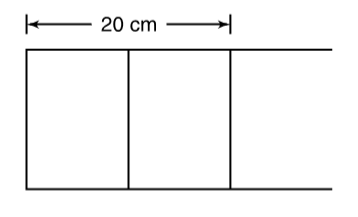Figure shows a cylindrical container containing oxyegn (γ=1.4) and closed by a 50 kg frictionless piston. The area of cross section is 100cm(2) , atmospheric pressure is 100kPa+E2 and g is 10 m s^(-2). The cylinder is slowly heated for some time. Find the amount of heat supplied to gas if the piston moves out through a distsnce of 20 cm.
 .Solution in Tamil
.Solution in Tamil
γ=1.4, Weight of piston (w) =50kg, Area of cross section of piston(A)
=100cm2
Atmospheric pressure (P0)=100kPa,
g=10m/s2,x=20cm,
dW=Pdv=(mgA+P0).Adx
=(50×10100×10−4+105)
(100×10−4×20×10−2)
=(5×104×105)×20×10−4
=1.5×105×20×10−4
=300J.
Hence nRdT=300ltbgt dT=300nR ltbgt So, dQ=nCpdT=ncp×(300nR)
=nγR300(γ−1)nR
=(300×1.40.4)
=1050J
Topper's Solved these Questions
Similar Questions
A wave of wavelength 0.60 cm is produced in air and it travels at a speed of 300 ms^-1. Will it be audible?
View SolutionThe gravitational force acting on a particle of 1 g due to a similar particle is equal to 6.67×10−17N. Calculate the separation between the particles.
View SolutionA cylidrical vesel containing a liquid is closed by a smooth piston of mass m as shown in the figure. The area of cross section of the piston is A. If the atmospheric pressure is P0, find the pressure of the liquid just below the piston.
 ,
,
View SolutionA gas is enclosed in a cylindrical vessel fitted with a frictionless piston.the gas is slowly heated for some time. During the process, 10 J of heat is suopplied and the piston is found to move out 10cm. Find the increase in the internal energy of the gas , the area of cross section of the gas, the area of cross section of the cylinder=4 cm^(4) and the atmospheric pressure =100 kPa.
View SolutionA gas is enclosed in a cylindrical vessel fitted with a frictionless piston. The gas is slowly heated for some time. During the process, 10 J of heat is supplied and the piston is found to move out 10 cm. The area of cross-section of the cylinder =4cm2 and the atmospheric pressure =100kPa.
View SolutionIn given figure, gas is slowely heated for sometime. During the process, the increases in internal energy of the gas is 10J and the piston is found to move out by 25cm , then find the amount of heat supplied. The area of cross-section of cylinder = 40cm^(2) and atmospheric pressure 100 kPa
View SolutionIn a cylindrical container two pistons enclose gas in two compartments as shown in the figure. The pistons have negligible thickness and can move without friction. The sys- tem is originally in equilibrium. The outer piston is slowly moved out by 10 cm and the inner piston is found to move by 4 cm. Find the distance of the inner piston in equilibrium from the closed end of the cylinder if the outer piston is slowly moved out of the cylinder. Assume temperature of the gas to remain constant.

View SolutionIn the arrangement shown in figure, the piston can smoothly move inside the cylinder. The mass of the piston is m = 100 g and its cross sectional area is A = 10 cm^(2) . The length of air column at temperature of T = 27^(@)C is 10 cm. Overall length of the cylinder is 20.4 cm. The container is turned upside down and the length of the air column in equilibrium was found to be l at 27^(@)C . Take R = (25)/(3)J mol^(-1) K^(-1) and assume air to be diatomic gas. g = 10 m//s^(2) , atmospheric pressure is 1.01 xx 10^(5) Nm^(2) (a) Find l (b) If the air in the container is supplied heat in upside down position, the piston slowly begins to move down, and ultimately it gets ejected out of the cylinder. Calculate the amount of heat that the air must absorb for the piston to come out.
View Solution2 moles of a diatomic gas are enclosed in a cylinder piston arrangment. The area of cross section and mass of the piston are 1 cm^(2) and 1 kg respectively. A heater is supplying heat to the gas very slowly. Find heat supplied (in joule) by the heater is the piston moves through a distance of 10 cm. .
View Solutionঘর্ষণহীন পিস্টনযুক্ত একটি চোঙের মধ্যে 400KPa চাপে একটি গ্যাস আবদ্ধ আছে। বাইরে থেকে তাপ সরবরাহ করে প্রায়-স্থির (quasi−static) পদ্ধতিতে চাপ অপরিবর্তিত রেখে গ্যাসের উন্নতা বৃদ্ধি করা হল। পিস্টনটি ধীরে ধীরে 10cm উচ্চতা উঠে গেল পিস্টনের প্রস্থচ্ছেদের ক্ষেত্রফল 0.3m2 হলে গ্যাস দ্বারা কৃত কার্য হল
View SolutionA frictionless piston-cylinder based enclosure contains some amount of gas at a pressure of 400 kPa. Then heat is transferred to the gas at constant pressure in a quasi-static process. The piston moves up slowly through a height of 10 cm. If the piston has a cross-sectional area of 0.3 m^(2) , the work done by the gas in this process is
View Solution400 kPa दाब पर एक घर्षणरहित पिस्टन युक्त बेलन में गैस की कुछ मात्रा है तत्पश्चात् कवासी-स्थैतिक प्रक्रम में नियत दाब पर गैस को ऊष्मा स्थानांतरित की जाती है। पिस्टन धीरे -धीरे 10 cm की ऊँचाई तक विस्थापित हो जाता है। यदि पिस्टन का अनुप्रस्थ परिच्छेद क्षेत्रफल 0.3m2 है, तब इस प्रक्रिया में गैस द्वारा किया गया कार्य है
View SolutionA cylidrical vesel containing a liquid is closed by a smooth piston of mass m as shown in the figure. The area of cross section of the piston is A. If the atmospheric pressure is P0, find the pressure of the liquid just below the piston.
 ,
,
View SolutionA gas is enclosed in a cylindrical vessel fitted with a frictionless piston.the gas is slowly heated for some time. During the process, 10 J of heat is supplied and the piston is found to move out 10cm. Find the increase in the internal energy of the gas, the area of cross section of the cylinder=4cm2 and the atmospheric pressure =100kPa.
View SolutionA frictionless piston-cylinder based enclosure contains some amount of gas at a pressure of 400kPa. Then heat is transferred to the gas at constant pressure in a quasi-static process. The piston moves up slowly through a height of 10cm. If the piston has a cross-sectional area of 0.3m2, the work done by the gas in this process is
View SolutionA cylindrical vessel containing a liquid is closed by a smooth piston of mass m as shown in the figure. The area of cross section of the piston is A. If the atmospheric pressure is P0, find the pressure of the liquid just below the piston.
 ,
,
View Solution
